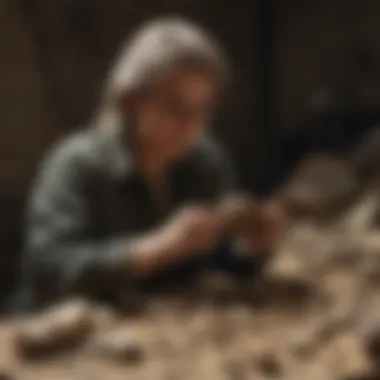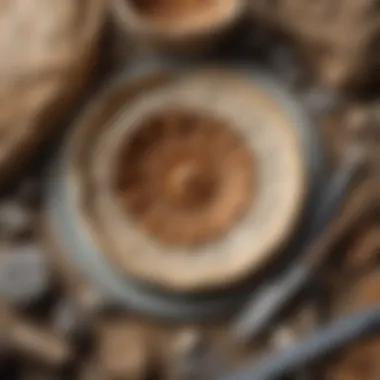The Art and Science of Buying Fossils: A Comprehensive Guide


Intro
Purchasing fossils is a complex and informative process that requires careful consideration of various factors. Within this guide, readers will find insights useful for both novice and expert collectors. These insights will highlight the importance of informed decision-making and ethical sourcing. Ultimately, this article aims to equip you with the knowledge to navigate the fossil market effectively.
Rock and Fossil Identification
Identifying rocks and fossils is an essential skill for any collector. Knowing the differences between types and their characteristics enhances one's ability to select quality specimens.
Types of Rocks and Fossils
Understanding where fossils come from begins with recognizing the basic types:
- Sedimentary Rocks: Most fossils form within these. They contain sediments deposited over time in water bodies.
- Igneous Rocks: These are formed from solidified magma and typically do not contain fossils.
- Metamorphic Rocks: These form under heat or pressure but contain few fossils.
Fossils vary significantly as well, including:
- Body Fossils: These are actual physical parts of the organism, like bones or teeth.
- Trace Fossils: Show evidence of behavior, such as footprints or burrows.
- Pseudofossils: These mimic biological patterns but are not actual fossils.
Characteristics to Look For
When dealing with fossils, essential characteristics to evaluate include:
- Non-Damage: Ensure there are no visible breaks or heavy coloration changes suggesting previous repairs.
- Completeness: More complete fossils usually have a higher value than partial ones.
- Provenance: Origin should be traceable to ensure authenticity. This can impact the price and importance of acquisition.
Tools for Identification
Certain tools simplify fossil identification:
- Hand Lens: Allows examination of faults other than visible flaws.
- Field Guide: Offers information on regional fossils and their geological characteristics.
- Pinpointer: Useful in locating fossils within the soil.
Collecting Tips and Techniques
The art of collecting fossils also involves practical techniques and guidelines.
Best Practices for Collecting
To maintain respect for the environment and encourage sustainable practices:
- Always keep local laws in mind; some areas prohibit excavation.
- Document your finds with photographs and notes to track their origin.
Locating Prime Collecting Sites
Effective research can turn up hidden gems:
- Libraries and online databases can provide information on previously explored areas.
- Joining local fossil clubs will often yield firsthand experience.
How to Safely Extract Specimens
Safety is paramount when collecting fossils. Here are useful tips:
- Tools like chisels should be used cautiously. Consider specialized tools made for fossil extraction to minimize damage.
- Always wear gloves to avoid injury. Additionally, wear goggles if there is a risk of debris.
Preservation and Display
After acquiring fossils, their preservation becomes crucial for their longevity.
Techniques for Preserving Rocks and Fossils
Conservation prevents natural deterioration whether through time or environmental factors:
- Drying: Allow specimens to air-dry in a cool, dry area.
- Sealants: Use appropriate adhesives to prevent moisture absorption and breakage.
Proper Storage Methods
Storing fossils allows them to maintain their integrity. Utilize the following:
- Acid-free containers reduce chemical interaction that may degrade minerals.
- A stable, temperature-controlled environment will also protect specimens from thermal shock.
Creative Display Ideas
A creative display not only showcases fossile findings but acts as a reminder of the geological history:
- Shadow boxes for individual specimens.
- Clear cases for group exhibits.Rotate displays periodically to offer refreshing perspectives.
Geological Insights


Understanding geological processes aids apprecating the context of fossils in nature.
Geological Formations and Processes
Fossils reflect Earth's story. Geologists divide time into major eras based on significant geological activity.
Historical Significance of Rocks and Fossils
Many fossils have played crucial roles in unraveling Earth's past ecosystems.
Notable Discoveries in the Field
History has showcased various pivotal fossil findings that shed light on ancient life, enrich knowledge about evolution, and provoke thoughts about our future core processes.
The process of buying fossils is an intriguing journey involving education, ethics, and sustainable practices. Keeping an informed mindset strengthens both a collector’s site value understanding and appreciation for paleontology.
Preamble to Fossils
The study and collection of fossils connect us to the distant past. Understanding fossils is critical for collectors and enthusiasts alike. This section explores the fundamental aspects of fossils, helping readers appreciate their definition, significance, and influence in both science and collecting.
Definition and Significance
Fossils are remains or impressions of organisms preserved in various geological formations. They can include a vast range of materials, from dinosaur bones to tiny organisms encapsulated in amber. The significance of fossils extends beyond mere historical curiosities. They serve as vital records of life on Earth, documenting evolution, genetics and species diversity across geological time.
By studying fossils, scientists gain a clearer picture of past climates and ecosystems, providing insights into how organisms adapted or went extinct. For collectors, this offers more than aesthetic appeal; each fossil carries a story of survival that may inform conservation efforts and deepen our understanding of life's resilience.
Fossils in Science and Collecting
The role of fossils in science cannot be overstated, as they are crucial for understanding Earth's history. Paleontology, the branch of science dedicated to studying fossils, combines aspects of biology, geology, and ecology. These fields intersect, enriching our comprehension of life's path on our planet.
Collectors are vital to this landscape. They not only seek out fascinating specimens but also often become advocates for responsible collection practices. When removing fossils from their natural settings, attention must be paid to legal and ethical standards to ensure preserving scientific and cultural integrity. As fossils often raise curiosity in the public sphere, educating oneself on proper sourcing methods and best practices for conservation leads to a more informed collection generally.
Types of Fossils Available
Understanding the various types of fossils is crucial for both novice and experienced collectors. This knowledge not only aides in identifying genuine fossils but also helps in recognizing their potential value and significance. Fossils come in many forms, which vary based on their formation processes, age, and rarity. By grasping the nuances of different fossil types, collectors can make educated decisions about their purchases, ensuring that they acquire pieces that contribute meaningfully to their collections.
Mineralized Fossils
Mineralized fossils are perhaps the most recognized type of fossils. These fossils occur when organic material, such as bones or shells, is gradually replaced by minerals over time, forming a cast of the original item. This process can lead to exquisite details, as the structure of the original organism is strikes under the converted mineral. Examples include dinosaur bones, trilobite remains, and even marine specimens like belemnites.
Key points regarding mineralized fossils include:
- They often exhibit remarkable preservation.
- Rarity and depth of mineralization significantly affect their value.
- Proper provenance is essential. Gathering information on the fossil's origin adds value and authenticity to the coaching.
When sourcing mineralized fossils, consider the geographical area they come from. Certain regions are notorious for high-quality specimens that command premiums.
Imprints and Casts
Imprints and casts provide an intriguing counterpart to mineralized fossils. Instead of the actual material replacing the original, these fossils capture the shape and texture of the organism. An imprint displays the outline of the organism’s features, while a cast is a replica formed when a mold of the imprint fills with some mineral-rich material. They often offer insights into the life of species long extinct.
Notable elements of imprints and casts:
- Typically, they can be found more readily than fully mineralized fossils.
- Common within specific ecological layers, their significance is well noted by paleontologists.
- Authentication can be tricky; many imitative techniques can duplicate them.
Collectors appreciate these fossils for their representations of diverse ecosystems. However, buyers should be cautious of illusions created in the market; authenticating them can require careful scrutiny.
Amber and Other Preserved Specimens
Amber and other preserved specimens represent a captivating aspect of fossilization. Amber forms from tree resin that captures insects or plants over millions of years. Such discoveries not only offer glimpses into ancient ecosystems but reveal remarkable detail in the organisms trapped within.
Key features about amber and these preserved specimens:
- They hold immense appeal due to their aesthetic form and often complex ecosystems.
- Prices when buying can vary wildly, influenced by the quality and contents.
- Collectors must be cautious of imitations, as synthetic and processed forms infiltrate the marketplace.
Many miners and amateur fossil hunters look for amber because it symbolizes preservation at its finest. Potential buyers often are enticed by unique inclusions that can tell stories about ancient life.
In evaluating fossil types, the breadth of understanding each category informs educated choices. Observing the differences in formation, authenticity, and value plays a significant role in shaping one's collecting journey.
Understanding the Fossil Market
Understanding the fossil market is essential for anyone interested in collecting. This market involves complex social, economic, and ethical factors that can greatly influence the purchasing experience. It offers insights not only into what types of fossils may be available but also provides context regarding their value and significance to collectors.
The importance lies in gaining clarity about these factors, which helps collectors make informed decisions. By grasping the historical context and current pricing trends, collectors position themselves to navigate potential challenges effectively while honing in on valuable specimens.
Furthermore, comprehending this market can illuminate why provenance plays such a critical role. Knowing the background of a fossil empowers collectors to confirm legitimacy and ethical considerations of the purchase. Overall, a deep understanding fosters a more enriching collection experience.


Historical Context
The fossil market has evolved considerably over time. Initially, fossils gained recognition mainly among scientists and naturalists fascinated by the remnants of past life. Many prominent figures contributed to this field, notably in the 19th century. As scientific understanding progressed, the allure of fossils reached broader audiences, eventually morphing into a collectible market.
Fossils were historically viewed through a lens of curiosity rather than economic value. Nevertheless, as their rarity and aesthetic appeal became unmistakable, the view changed. With organized digging and discovery, commercial markets began to emerge, guiding how fossils’re purchased and valued today. This shift into a more commercial endeavor has had lasting implications.
Notably, nations implemented various laws regarding fossil ownership, excavation rights, and export regulations. These legal frameworks shaped the dynamics of fossil collection and trade, fostering a need for ethical collecting practices that collectors must now consider carefully.
Current Trends and Pricing
In modern times, the fossil market exhibits fluctuating trends. Research and findings within paleontology influence the availability and desirability of specific specimens. For example, recent discoveries have heightened interest in particular eras or species, driving up prices. Meanwhile, older fossils ebb and flow in value based on nostalgia and novelty.
Currently, the relics from the Dinosaur era are particularly aggregated and often hold significant financial value. Besides dinosaur fossils, rare marine or prehistoric mammal fossils like the woolly mammoth fetch decent prices at auctions. The interaction between sophistication and collectors continues to impact thriving segments within this market.
Prices can vary dramatically based on rarity, condition, and scientific importance. For instance, certain index fossils often serve as keystones and tend to command higher prices compared to more commonly found specimens. This disconnect can be attributed to transaction demand and private sales, where value is often subjective.
When venturing into purchase, it's advisable to keep an eye on online platforms, fossil shows, and specialty shops, not only for pricing insights but also for staying current on trends. The lingering momentum around speculation and investment often leads collectors to reshape their approach toward spending and assessing fossil value today.
“A well-informed collector possesses the ability to authenticate the purchase and explore authentic value tion with precision.”
Ethics in Fossil Collecting
The realm of fossil collecting presents unique challenges and opportunities. As enthusiasts engage in acquiring specimens, it is essential to recognize that the ethics behind fossil collecting go beyond personal interest or profit. Ethical considerations impact the sustainability of fossil resources, scientific integrity, and the preservation of cultural heritage. Informed collectors must embrace ethical practices to ensure their contributions to the field are responsible and meaningful.
Legal Considerations
Understanding the legal landscape of fossil collecting is paramount. Different countries have various laws concerning fossil ownership and collection. Familiarizing oneself with these regulations enhances the legal and ethical framework for any fossil enthusiast.
- Ownership Rights: Investigate whether fossils are legally owned or protected by governmental regulations. Some locations do prohibit the collection of fossils, making it vital to seek permission before extraction.
- Export Laws: When considering the purchase of fossils from international sources, it is crucial to be aware of export laws. Each country has specific criteria regarding what can and cannot be taken out of its borders.
- Documentations: Legitimate sellers should provide all necessary documentation proving legality of acquisition. This adds value and ensures authenticity.
Legal compliance should be non-negotiable, as it reflects respect for both the present and future states of fossil collections.
Sustainable Sourcing Practices
Ethical fossil collecting also hinges on sustainable sourcing practices. Collectors and businesses alike must adopt methods that do not exploit fossil resources or disturb fragile ecosystems. The sustainability of fossil resources is, in fact, participating in conscientious decision-making.
- Collect Responsibly: In regions where fossil collecting is legal and encouraged, choose to collect specimens that have minimal environmental impact.
- Provenance Awareness: Seek fossils with clear provenance that illuminate their origin. Knowing where a fossil came from supports environmental sustainability and prevents illegal sourcing.
- Educational Partnerships: Engage with museums and educational institutions that prioritize conservation. Involvement in educational outreach promotes responsible collecting and paves way for future generations to enjoy fossil findings.
Ethics should shape how collectors navigate their interests, encouraging approaches centered on integrity and mutual respect for nature and culture.
Making ethical choices in fossil collecting is meant not just for individual collectors but for the shared responsibility of preserving our planet's natural history for future exploration and study.
Where to Buy Fossils
Navigating the fossil buying landscape requires knowledge of where to source these specimens. Informed collectors understand that both the venue and the method of purchasing can influence quality, authenticity, and price. Buyers' choices are often dictated by personal preferences, availability, and the specific types of fossils sought. The importance of this section cannot be understated, as it guides collectors in targeting the best opportunities for acquiring fossils, ensuring that their collections are robust and reliable.
Online Marketplaces
The rise of online marketplaces has revolutionized how collectors buy fossils. Websites like eBay, Etsy, and specialized platforms such as FossilEra and Paleoworld provide an accessible approach to finding fossils. The vast expanse of the internet allows collectors to showcase their collections to a global audience, often uncovering unique specimens not found locally. Here are several essential points when considering online marketplaces:
- Variety: Online platforms boast extensive inventories that range across types, prices, and regions. Inspecting multiple listings aids in gauging market trends and average pricing.
- User Reviews: The feedback loop through customer reviews enhances trust in sellers. Neglecting to examine these reviews could lead to undesirable purchases.
- Shipping Considerations: Fossils require careful handling due to their fragile nature. Buyers must pay attention to shipping policies and returns, especially with items shipped from international locations.
An informed decision-making process can save time and money, as well as ensure genuine fossils are added to your collection.
Providing the right conditions for negotiations is vital in an online transaction framework, and collectors should remain aware of current pricing trends in order to avoid overpaying.
Specialty Shops and Auctions
Physical specialty shops and auctions present a different landscape for fossil acquisitions. This mode embraces personal interaction and often provides profound insights directly from sellers. Collectors can witness the fossils in person, which aids in verifying authenticity and quality.
- Immediate Examination: Shop visits provide the chance to inspect details like structure and patina, essential for determining value.
- Expertise: Specialized stores and auctions often have knowledgeable personnel on hand. They can offer invaluable information regarding the specimens, local finds, and best practices in maintaining fossils.
- Auctions and Displays: Fossil auctions can be a thrilling experience where bidding may unearth extraordinary specimens missed online. Observing prices at public auctions develops a deeper understanding of value dynamics.
Collectors should register with auction sites such as Bonhams or Paddle8 to stay updated on fossil events. This not only opens up avenues for rare piece acquisitions but also fosters a connection between collectors and the broader fossil community.
In summary, both online marketplaces and specialty shops with auctions equip collectors with different tools for buying fossils. Understanding the sufficiency, limitations, and advantages of each remains crucial to an efficient collection strategy.
Evaluating Fossil Quality
Evaluating the quality of fossils is crucial for anyone involved in collecting. A fossil's quality affects its value, significance, and ultimately, the satisfaction a collector derives from their purchase. Whether you are a novice, an intermediate, or an advanced collector, taking the time to assess the various elements that contribute to a fossil’s quality is essential. This process goes beyond mere aesthetics; it involves understanding the intricate details that make a specimen unique and worthy of investment.
Factors Influencing Value
Several factors come into play when determining the value of a fossil. These influences span various aspects.
- Rarity: More rare specimens naturally command higher prices. Collecting fossils from species or times that are less represented in collections can enhance your collection's value.
- Condition: A fossil in better condition tends to fetch a higher price. Something with cracks or breakage or excessive wear may be less desirable. Inspect it closely for this.
- Provenance: Knowing the fossil's history of ownership and that it was ethically sourced adds to its credibility and monetary value. A well-documented provenance stands as testimony to its authenticity.
- Species Identification: Certain species are sought after more than others due to unique traits or extensive fossil records, affecting the worth positively or negatively. Understanding what types appeal to collectors can help in your efforts.
- Scientific Importance: The fossil’s implication in studies of evolution or geology can affect its importance. Specimens that fill gaps or help clarify certain periods or transitions are highly valuable.


As you analyze the quality of a fossil, consider these factors carefully. They offer a framework for assessing whether the potential investment aligns with your goals.
Signs of Authenticity
Establishing authenticity is vital in the market of fossils, particularly given the existence of reproductions and forgeries. The following signs can assist you in determining whether a specimen is real:
- Natural Features: Genuine fossils often exhibit natural features, like small imperfections or irregularities that should be present in ancient specimens. Examine it carefully for these traits.
- Scientific Analysis: Labs can analyze fossils for their mineral composition. A detailed report can confirm or deny a fossil's authenticity, lending significant credibility to any assessment.
- Reputable Sources: Purchase from established dealers known for selling genuine fossils rather than unknown sources. Each piece should come with clear documentation regarding authenticity.
- Visual Inspection: Look for elements typical in genuine fossils, like discoloration consistent with geological processes or evidence of sedimentary layers. Something appearing overly pristine or too perfect might raise red flags.
The more knowledge you possess regarding the qualities of both authentic and counterfeit fossils, the better equipped you will be to navigate this fascinating yet complicated market.
Once you integrate these evaluation strategies into you purchasing process, you stand to ensure that your collection not only thrives but grows in both relevance and value.
Caring for Your Fossil Collection
Caring for a fossil collection is essential for preserving its value and significance. Collectors must understand that fossils provide insights not just into prehistoric life, but also into Earth's broader historical narrative. Proper care extends their lifespan, maintains aesthetic appeal, and upholds their educational worth. As the owner of a fossil, it becomes your responsibility to ensure the specimen withstands the test of time.
Storage Solutions
Effective storage is one of the foundational aspects of fossil care. Ideally, fossils should be kept in a climate-controlled environment to prevent degradation due to temperature fluctuations and high humidity. Using padded boxes or dedicated shelves can greatly minimize physical damage. Each piece deserves a carefully designated area, which helps to avoid unintentional mixing of specimens, thus maintaining their provenance.
Specific materials for storage include:
- Archival-quality boxes: They are free from chemicals that may contribute to deterioration.
- Acid-free tissue paper: Ideal for wrapping sensitive fossils, providing a layer of protection.
- Plexiglass cases: Useful for displaying while keeping dust and other pollutants away.
Maintaining stability ensures your collection remains intact for years to come. Each fossil’s unique attributes must be considered to tailor the storage accordingly.
Cleaning and Preservation Techniques
Cleaning fossils is a delicate undertaking. Improper cleaning methods may result in irreversible damage. Collectors should avoid using harsh chemicals or abrasive materials. Instead, light brushing with a soft brush is often sufficient for various fossil types. If dirt or other particulates need further attention, distilled water and applications using damp cotton swabs are recommended.
For preservation, it is vital to understand that some fossils may require consolidants to stabilize their structure. These processes should be approached with caution and ideally executed by professionals when possible. Moreover, documenting restoration efforts contributes valuable provenance records to the collection, bolstering its overall narrative.
“In the end, the health of your fossil collection is indicative of your dedication as a collector.”
With proper storage, cleaning, and preservation techniques, collectors can enhance the authenticity and longevity of their fossils. Following these guidelines will not only protect your investment but also contribute to the wider understanding of our planet's rich history.
The Community of Fossil Collectors
The realm of fossil collectors encompasses much more than just individual pursuits; it is a vibrant community that fosters connections, information exchange, and shared passions. This community is important as it offers numerous benefits for both novice and experienced collectors. The significance of participating in this community includes gaining knowledge about fossil identification, learning best practices in collecting and caring for fossils, and experiencing camaraderie with others who share similar interests. Connections formed can lead to opportunities for trade, sale, or simply the enjoyment of shared expeditions.
Connecting with Other Collectors
Connecting with fellow fossil collectors is an essential facet of cultivating one's passion. Online platforms have deeply transformed this connection-making. Websites like Reddit or dedicated Facebook groups provide spaces where collectors can seek advice, share their latest finds, or engage in discussions about fossil preservation techniques.
Moreover, localized fossil collecting clubs can be beneficial. These groups often organize field trips, educational sessions, and discussions about ethical collecting practices that can aid newcomers. When collectors collaborate, they can tap into each other's expertise. Learning from seasoned individuals can significantly fast-track the knowledge of newbies in understanding fossil provenance, rarity, and types.
- Online platforms include forums where fossil-related questions get answered.
- Local clubs enhance the collecting experience.
Through these networks, collectors can stay updated on significant discoveries or interesting scientific research related to paleontology. Dariginal chimney수 rey transfer froggyst secure crashing friging foreign lizaanning competentлід
Participating in Shows and Events
Fossil shows and expos are noteworthy opportunities for collectors to immerse themselves in the community. These events are essential as they bring together a wide variety of enthusiasts, dealers, and researchers. Events often feature exhibitors showcasing impressive collections, allowing individuals to view rare specimens. This exposure can provide valuable insights into how to evaluate fossils' qualities, thus influencing subsequent purchasing decisions.
Engagement in these events can lead to practical experiences. Lectures and presentations from experts can further illuminate themes such as ethics, best practices, and novelties in fossil markets. Additionally, networking during these occasions can open doors for collaborations and learning ventures.
Quotation from seasoned collector to highlight the importance:
“Building relationships is as essential as building your collection. Every interaction can teach you something new.”
Involved collectors often express how participating in shows enriched their understanding and positioned them well within the community. Building relationships at these events has been instrumental for many in their collecting journeys, because these shared experiences often become the bedrock for loyal friendships and partnerships in the future. To truly grasp the fullness of the fossil world, involvement and integration are key.
Overall, the sense of belonging while cooperating and sharing experiences makes the community of fossil collectors a vital aspect of the collecting journey, one that reaffirms the importance of informed and ethical collecting.
Ending
The process of acquiring fossils requires insight and understanding, not just a financial investment. Informed collecting enhances one’s appreciation for both the history fossil represent and the ethical considerations surrounding their purchase. By prioritizing knowledge over impulse, collectors can better navigate the complex fossil market.
The Value of Informed Collecting
Understanding the dimensions of informed collecting serves as the bedrock in advancing personal collections. Every collector must recognize the significance of provenance—the origin and history of each fossil. Collectors who can verify the source of their fossils are often able to ensure they are supporting ethical practices. Whether through print publications, online resources, or community events, education plays a critical role in this pursuit. Educated collectors often make wise decisions, thus benefiting themselves in the long run.
Being informed can prevent mistakes that could result in legal ramifications or owning fakes. Knowledge about different fossil types, characteristics to look for, and local and international laws can guide collectors, making the process of buying exciting rather than treacherous.
Future Trends in Fossil Collecting
Observing how fossil collecting evolves can shed light on both societal implications and scientific advancements. Currently, there is a noticeable trend towards sustainability and responsible sourcing. Collectors around the world are becoming more mindful of their choices and the long-term impact of their purchases.
Digital advancements and blockchain technology are beginning to find their way into the makin of transactions, increasing transparency. Technology allows for better validation methods, combating the sale of counterfeit fossils. Community engagement through social media platforms like Reddit or Facebook enables direct connections among collectors, fostering an environment of shared knowledge.
Going forth, the blending of scientific advancement and ethical awareness will likely guide the vision of future fossil collecting. Collecting will remain a unique intersection of history, conservation, and personal investment. As considerations around climate change influences choices about collections, a proactive, informed mindset will be essential.







